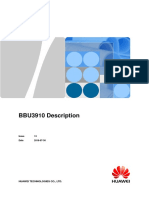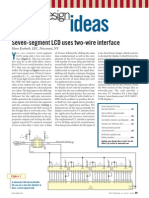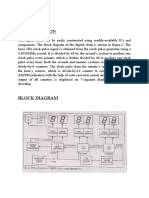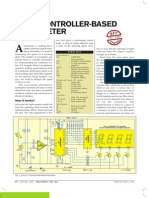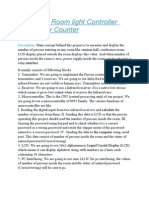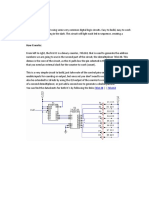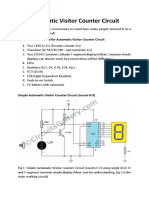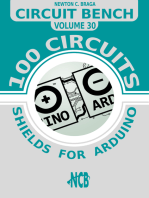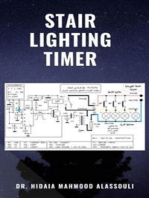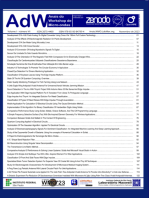Prjcts On Timers & Counters
Prjcts On Timers & Counters
Uploaded by
Vamsi Mani Deep ElapakurtyCopyright:
Available Formats
Prjcts On Timers & Counters
Prjcts On Timers & Counters
Uploaded by
Vamsi Mani Deep ElapakurtyOriginal Title
Copyright
Available Formats
Share this document
Did you find this document useful?
Is this content inappropriate?
Copyright:
Available Formats
Prjcts On Timers & Counters
Prjcts On Timers & Counters
Uploaded by
Vamsi Mani Deep ElapakurtyCopyright:
Available Formats
Make a Digital Stop Watch
Description
A digital stop watch built around timer IC LM555 and 4-digit counter IC MM74C926 with multiplexed 7-segment LED display.MM74C926 consists of a 4-digit counter, an internal output latch, npn output sourcing drivers for common cathode,7-segment display and an internal multiplexing circuitry with four multiplexing outputs.The counter advances on negative edge of the clock. The clock is generated by timer IC LM555.The circuit works off a 5V power supply. It can be easily assembled on a general-purpose PCB. Enclose the circuit in a metal boxvwith provisions for four 7-segment displays, rotary switch S1, start/stop switch S2 and reset switch S3
Testing
First, reset the circuit by pressing S3 so that the display shows 0000. Now open switch S2 for the stop watch to start counting the time. If you want to stop the clock, close S2. Rotary switch S1 is used to select the different time periods at the output of the astable multivibrator (IC1).
Digital Timer Circuit Diagram .
Digital Step Km Counter Circuit
This circuit is designed for measures the distance covered during a walk. Hardware is located in a small box slipped in pants' pocket and the display is conceived in the following manner: the leftmost display D2 (the most significant digit) shows 0 to 9 Km. The rightmost display D1 (the least significant digit) shows hundred meters and its dot illuminates after every 50 meters of walking. A beeper (excludable), signals each count unit, occurring every two steps. This is the figure of the circuit;
This circuit has operation with based on 2 IC. IC1A & IC1B form a mono stable multi vibrator providing some degree of freedom from excessive bouncing of the mercury switch. Therefore a clean square pulse enters IC2 that divides by 64. Q2 drives the LED dot-segment of D1 every 32 pulses counted by IC2. Either IC3 & IC4 divide by 10 and drive the displays. P1 resets the counters and P2 enables the displays. IC1C generates an audio frequency square wave that is enabled for a short time at each mono stable count. Q1 drives the piezo sounder and SW2 allows to disabled the beep. A normal step was calculated to span around 78 centimeters, thus the LED signaling 50 meters illuminates after 64 steps (or 32 operations of the mercury switch), the display indicates 100 meters after 128 steps and so on. For low battery consumption the display illuminates only on request, pushing on P2. Accidental reset of the counters is avoided because to reset the circuit both pushbuttons must be operated together. Part: R1,R3____22K 1/4W Resistor R2________2M2 1/4W Resistor R4________1M 1/4W Resistor R5,R7,R8__4K7 1/4W Resistor R6_______47R 1/4W Resistor
R9________1K 1/4W Resistor C1_______47nF 63V Polyester Capacitor C2______100nF 63V Polyester Capacitor C3_______10nF 63V Polyester Capacitor C4_______10F 25V Electrolytic Capacitor D1_______Common-cathode 7-segment LED mini-display (Hundreds meters) D2_______Common-cathode 7-segment LED mini-display (Kilometers) IC1______4093 Quad 2 input Schmitt NAND Gate IC IC2______4024 7 stage ripple counter IC IC3,IC4__4026 Decade counter with decoded 7-segment display outputs IC Q1,Q2___BC327 45V 800mA PNP Transistors P1_______SPST Pushbutton (Reset) P2_______SPST Pushbutton (Display) SW1______SPST Mercury Switch, called also Tilt Switch SW2______SPST Slider Switch (Sound on-off) SW3______SPST Slider Switch (Power on-off) BZ_______Piezo sounder B1_______3V Battery (2 AA 1.5V Cells in series)
You might also like
- Huawei BBU3910 DescriptionDocument50 pagesHuawei BBU3910 DescriptionLê Hữu Ái100% (12)
- Infrared Object CounterDocument9 pagesInfrared Object CounterMohideen NazimNo ratings yet
- Basic Stop WatchDocument13 pagesBasic Stop WatchAqib Yasin100% (1)
- Digital Thermometer Using 8051 Microcontroller Project ReportDocument18 pagesDigital Thermometer Using 8051 Microcontroller Project Reportjs18ps56% (9)
- Scaffold CalculatorDocument3 pagesScaffold CalculatorJonathan Brylle Cardinal25% (4)
- Wa0006.Document4 pagesWa0006.Tãyyâb ShahNo ratings yet
- 10 - Mini ProjectsDocument20 pages10 - Mini ProjectsMohammed Bin JafarullahNo ratings yet
- Full Paper of Put Coin and Draw Power 2010Document9 pagesFull Paper of Put Coin and Draw Power 2010Biswajit SarkarNo ratings yet
- DC-DC Converter: ContentDocument11 pagesDC-DC Converter: ContentguillermomolteniNo ratings yet
- Speed Checker For Highways: THURSDAY, JULY 15, 2010Document5 pagesSpeed Checker For Highways: THURSDAY, JULY 15, 2010Prince AlenNo ratings yet
- Put Coin and Draw PowerDocument74 pagesPut Coin and Draw PowerAjaysinh ParmarNo ratings yet
- Traffic Signal: Digital Logic DesignDocument10 pagesTraffic Signal: Digital Logic DesignNeha ArifNo ratings yet
- Rotary EncoderDocument6 pagesRotary EncoderalesysNo ratings yet
- An 023Document8 pagesAn 023SoumitraNo ratings yet
- Pre-Lab 2 (2)Document3 pagesPre-Lab 2 (2)SILENT KILLER GAMINGNo ratings yet
- Design: IdeasDocument6 pagesDesign: IdeasSamantha EwingNo ratings yet
- ProjectDocument8 pagesProjectHarshit JainNo ratings yet
- MICROCONTROLLER-based DC Motor Speed ControllerDocument8 pagesMICROCONTROLLER-based DC Motor Speed Controllerranjithsim100% (1)
- Termometro Digital RemotoDocument7 pagesTermometro Digital RemotoSandiego GomesNo ratings yet
- Uc Based TachometerDocument4 pagesUc Based TachometerB Hari KrishnaNo ratings yet
- Industrial TimerDocument4 pagesIndustrial TimerDeepak KuttathNo ratings yet
- Digital Clock CircuitDocument8 pagesDigital Clock CircuitPrabuddha ChakrabortyNo ratings yet
- Put Coin and Draw Power - Full Circuit ExplainationDocument6 pagesPut Coin and Draw Power - Full Circuit Explainationfa0003967No ratings yet
- Mains Interruption Counter With Indicator Circuit DiagramDocument6 pagesMains Interruption Counter With Indicator Circuit DiagramSelvy SalfitriNo ratings yet
- Frequêncimetro Dgital (7226B)Document2 pagesFrequêncimetro Dgital (7226B)Jose AlmeidaNo ratings yet
- Spo2 Circuit DesignDocument9 pagesSpo2 Circuit DesignNorazimah Mat ZainNo ratings yet
- Block Diagram For Simple Traffic Light SystemDocument17 pagesBlock Diagram For Simple Traffic Light SystemVishwaraj Bhagwat88% (16)
- Circuit Can Be Used For Many PurposesDocument1 pageCircuit Can Be Used For Many PurposesAszhar Al AmbaryNo ratings yet
- Ejemplo ICL7106 An023Document8 pagesEjemplo ICL7106 An023bl19cm7No ratings yet
- Advanced LED Temperature IndicatorDocument9 pagesAdvanced LED Temperature Indicatorkuravadi05No ratings yet
- Index: Objective Introduction Circuit Description List of Components Circuit Diagram Components DescriptionDocument19 pagesIndex: Objective Introduction Circuit Description List of Components Circuit Diagram Components DescriptionKrishnaBihariShuklaNo ratings yet
- Automatic Room Light Controller With Visitor Counter: DescriptionDocument10 pagesAutomatic Room Light Controller With Visitor Counter: DescriptionDanny PinheiroNo ratings yet
- LM8365 Alarm Digital Clock For BeginnersDocument7 pagesLM8365 Alarm Digital Clock For BeginnersMd Kamruzzaman KhanNo ratings yet
- 1 Level 1. LED Chaser: 74ls138 74ls163Document5 pages1 Level 1. LED Chaser: 74ls138 74ls163Sahil BhatiaNo ratings yet
- Digital Fan RegulatorDocument31 pagesDigital Fan RegulatorManoj GurralaNo ratings yet
- De-Generator: DIY Sample SynthesizerDocument30 pagesDe-Generator: DIY Sample Synthesizeromega776No ratings yet
- Ic 7107 As VoltmeterDocument7 pagesIc 7107 As VoltmetershivaniNo ratings yet
- Speed Checker For Highways ReportDocument44 pagesSpeed Checker For Highways ReportMahesh Kumar Vaish45% (11)
- People or Object Counter Circuit Diagram Using IC 555 and IC 4026Document4 pagesPeople or Object Counter Circuit Diagram Using IC 555 and IC 4026Maryam AsadNo ratings yet
- Automatic Visitor Counter CircuitDocument4 pagesAutomatic Visitor Counter CircuithloNo ratings yet
- Traffic Light ControlDocument20 pagesTraffic Light ControlDharmi JaviyaNo ratings yet
- CD4060 Timer Circuit 1 Minute To 2 HoursDocument9 pagesCD4060 Timer Circuit 1 Minute To 2 HoursBabu Variath100% (1)
- 2 Digit CounterDocument12 pages2 Digit Counterरघुनंदन भगीरथ चरखाNo ratings yet
- Automatic Room Light Controller With Bidirectional Visitor CounterDocument37 pagesAutomatic Room Light Controller With Bidirectional Visitor Counteramysure150% (2)
- DC Motor Controller USING MCDocument6 pagesDC Motor Controller USING MCkesavramNo ratings yet
- Analog Dialogue, Volume 48, Number 1: Analog Dialogue, #13From EverandAnalog Dialogue, Volume 48, Number 1: Analog Dialogue, #13Rating: 4 out of 5 stars4/5 (1)
- Reference Guide To Useful Electronic Circuits And Circuit Design Techniques - Part 1From EverandReference Guide To Useful Electronic Circuits And Circuit Design Techniques - Part 1Rating: 2.5 out of 5 stars2.5/5 (3)
- Reference Guide To Useful Electronic Circuits And Circuit Design Techniques - Part 2From EverandReference Guide To Useful Electronic Circuits And Circuit Design Techniques - Part 2No ratings yet
- Exercises in Electronics: Operational Amplifier CircuitsFrom EverandExercises in Electronics: Operational Amplifier CircuitsRating: 3 out of 5 stars3/5 (1)
- Exploring Arduino: Tools and Techniques for Engineering WizardryFrom EverandExploring Arduino: Tools and Techniques for Engineering WizardryRating: 4.5 out of 5 stars4.5/5 (5)
- Digital LED Thermometer with Microcontroller AVR ATtiny13From EverandDigital LED Thermometer with Microcontroller AVR ATtiny13Rating: 5 out of 5 stars5/5 (1)
- Design of Electrical Circuits using Engineering Software ToolsFrom EverandDesign of Electrical Circuits using Engineering Software ToolsNo ratings yet
- Cdp6853 CIA DatasheetDocument19 pagesCdp6853 CIA DatasheetRuben AparicioNo ratings yet
- Victrix Pro BFG Digital QSGDocument6 pagesVictrix Pro BFG Digital QSGAiNo ratings yet
- Application Note - Failure Analysis ChecklistDocument3 pagesApplication Note - Failure Analysis ChecklistCosmin PopescuNo ratings yet
- Control System For Modern HouseDocument11 pagesControl System For Modern HouseAakash Sheelvant100% (1)
- Morris ManoDocument29 pagesMorris Manojupillisjohn_9650432100% (4)
- Low Power Design Ow Based On Unified Power Format and Synopsys Tool ChainDocument5 pagesLow Power Design Ow Based On Unified Power Format and Synopsys Tool Chainrohan357No ratings yet
- UNIT 2 PV Energy SystemsDocument44 pagesUNIT 2 PV Energy SystemsVIJAYKUMAR GNo ratings yet
- Color Mixing LampDocument7 pagesColor Mixing LampDave RobisoNo ratings yet
- Eee Unit 1 For Video LectureDocument56 pagesEee Unit 1 For Video LecturePatel DipenNo ratings yet
- Power Line Carrier Communication (PLCC)Document12 pagesPower Line Carrier Communication (PLCC)Fayzan TahirNo ratings yet
- Ashwini ResumeDocument5 pagesAshwini ResumekalyanNo ratings yet
- 9 Reading ComprehensionDocument4 pages9 Reading ComprehensionhoorNo ratings yet
- "ZNR" Transient/Surge Absorbers: Recommended Applications FeaturesDocument20 pages"ZNR" Transient/Surge Absorbers: Recommended Applications FeaturesKodok NgorekNo ratings yet
- Inverter Air ConditioningDocument8 pagesInverter Air ConditioningKate Catherine RamosNo ratings yet
- Utran Kpi - Mapping - NSN Huawei - EricssonDocument129 pagesUtran Kpi - Mapping - NSN Huawei - Ericssonlekha20No ratings yet
- DC Trace: ScopeDocument4 pagesDC Trace: ScopeVimala KannanNo ratings yet
- Types of Transistors - Junction Transistors and FETsDocument16 pagesTypes of Transistors - Junction Transistors and FETsKrishanu ModakNo ratings yet
- Argus enDocument18 pagesArgus enMuhammad Usama ZahidNo ratings yet
- FSK NewDocument23 pagesFSK NewAnonymous l6MhRWNo ratings yet
- FTTH (Advanced)Document18 pagesFTTH (Advanced)muhammadsheheryarkNo ratings yet
- Architecture of DSP ProcessorsDocument13 pagesArchitecture of DSP ProcessorsSugumar Sar DuraiNo ratings yet
- USB To 4 Ports RS485/422 Converter User ManualDocument9 pagesUSB To 4 Ports RS485/422 Converter User ManualDamijan SrdočNo ratings yet
- ECE2132 Course Outlines SEM II 20132014Document7 pagesECE2132 Course Outlines SEM II 20132014Muhammad AzwirNo ratings yet
- QB On Application 2Document9 pagesQB On Application 2shailesh jhaNo ratings yet
- Thysseen Elevator Service MC2 ManualDocument47 pagesThysseen Elevator Service MC2 ManualRebecca DangNo ratings yet
- Sharp Lc-32le600e 40le600e 46le600e, Ru, S Parts Guide PDFDocument117 pagesSharp Lc-32le600e 40le600e 46le600e, Ru, S Parts Guide PDFcsibaludekNo ratings yet
- DIGITAL COMMUNICATION (Backlog) ECEN 3105Document4 pagesDIGITAL COMMUNICATION (Backlog) ECEN 3105soldieriron28No ratings yet
- Diodes Inc. 2N7002AQ 7 DatasheetDocument5 pagesDiodes Inc. 2N7002AQ 7 DatasheetkareemhamedNo ratings yet
